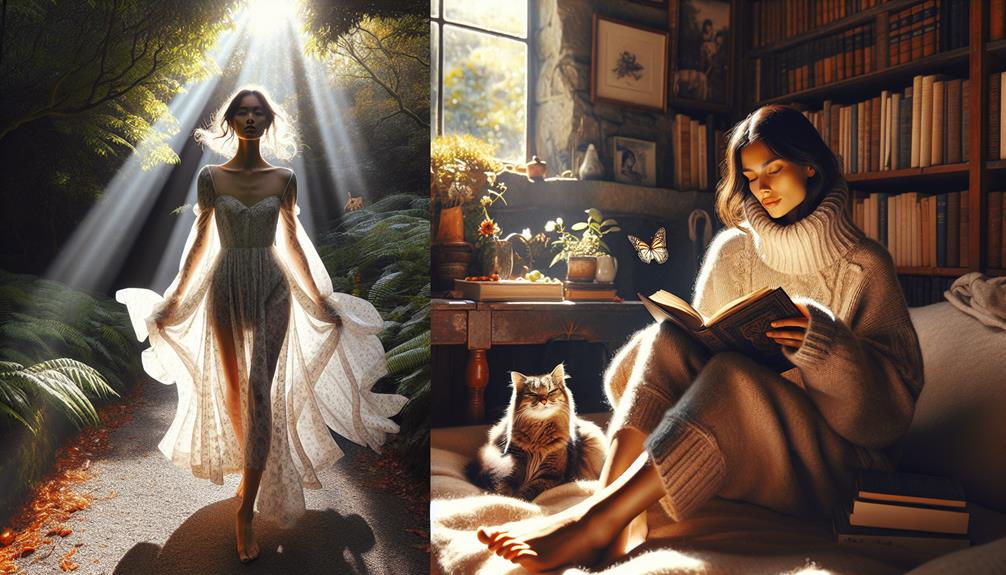I've worn chiffon on many hot days and I can confidently say it's one of the coolest fabrics out there. Due to its loosely woven nature and lightweight quality, chiffon doesn't trap much heat and allows air to flow freely, keeping you cool. It's not like heavier fabrics that hold onto the heat. Plus, the elegant drape of chiffon garments means they don't cling to your body, which also helps in staying cool. Lighter shades of chiffon are particularly great at reflecting the sun's rays, adding to its coolness. Just imagine how much more comfortable you could be in chiffon this summer!
Table of Contents
Key Takeaways
- Chiffon is lightweight and sheer, enhancing its breathability and making it cool to wear.
- Due to its loose weave, chiffon does not trap much heat, keeping the wearer comfortable.
- The fabric's flowy nature allows air to circulate freely, aiding in cooling during warm weather.
- Lighter shades of chiffon reflect sunlight, further reducing heat absorption and maintaining cooler body temperatures.
- Compared to heavier fabrics like cotton or silk, chiffon feels cooler and is preferable in hot climates.
Understanding Chiffon Fabric
Chiffon is a lightweight, sheer fabric often made from silk or synthetic materials like polyester. It's known for its flowy, ethereal look which makes it a favorite choice for evening wear and delicate blouses. The fabric's unique weave gives it a slight puckering effect in different directions, creating a texture that's both soft to touch and visually appealing.
When I choose chiffon for my outfits, I'm drawn to its elegant and graceful drape. The way it falls and flutters with the slightest breeze adds a touch of sophistication to any garment. Despite its delicate appearance, chiffon is surprisingly durable when handled with care. It's a testament to the fabric's versatility and enduring popularity in fashion.
Handling chiffon can be a bit tricky, though. It's slippery and can easily snag or tear if I'm not careful. Sewing with chiffon requires patience and gentle handling to maintain its integrity. But once I've mastered these challenges, the results are always worth the effort, yielding garments that are as beautiful to look at as they're to wear.
Chiffon's Breathability Factor
When I think about chiffon, I wonder how it handles heat. It's known for being light, but does that mean it's good at letting air flow through?
Let's look at how well it retains heat and if it's actually comfortable when it gets warm.
Chiffon Air Flow
I've noticed that the loosely woven nature of chiffon greatly enhances its breathability. This quality is crucial because it allows air to flow freely through the fabric, keeping the wearer cool and comfortable, especially in warmer climates.
The airy feel of chiffon is one of its most cherished attributes, making it a favorite for summer dresses and blouses. Its ability to let air pass through also means that sweat can evaporate off the skin more easily, reducing that sticky, uncomfortable feeling you get with less breathable materials.
When I wear chiffon, I feel like there's a constant, gentle breeze against my skin, which isn't only refreshing but also incredibly soothing on a hot day.
Heat Retention Properties
Despite its breezy nature, chiffon doesn't trap much heat, making it an excellent choice for staying cool. The fabric's light and airy qualities come from its very structure. Made typically from silk, cotton, or synthetic fibers, chiffon features a mesh-like weave that enhances its breathability. This means that as you wear chiffon, air flows freely through the fabric, allowing heat to escape rather than build up against your skin.
I've noticed that during warm days, chiffon keeps me feeling more comfortable compared to denser materials like denim or polyester, which tend to hold in heat. This characteristic makes chiffon particularly popular for summer dresses and blouses. It's the go-to fabric if you're looking for comfort without sacrificing style in the heat.
Comfort in Warmth
Building on chiffon's ability to keep heat at bay, its breathability significantly enhances comfort during warmer days. When I'm choosing an outfit for a hot day, I often reach for chiffon because I know it'll help me stay cool and dry. The fabric's unique weave allows air to flow freely, which prevents excessive sweating and discomfort.
Here's a quick comparison to give you a better idea:
| Feature | Chiffon | Heavier Fabrics |
|---|---|---|
| Air Flow | High | Low |
| Sweat Wicking | Excellent | Moderate |
| Cooling Effect | Very Effective | Less Effective |
Heat Retention in Chiffon
Now, let's talk about how well chiffon holds heat, which really ties into its breathability and thermal properties.
I've noticed that while chiffon feels light, the way it traps or releases heat can make a big difference in comfort.
We'll look at how these factors play out, especially in different environments or seasons.
Chiffon Fabric Breathability
Chiffon's lightweight and airy nature allows it to breathe well, making it a cool choice for warm weather wear. This fabric's unique weave and thin threads create a structure that's ideal for air circulation, which is crucial when you're trying to stay cool under the sun.
Let me paint a picture for you:
- Imagine a gentle breeze flowing through a softly draped chiffon curtain by an open window.
- Think of the lightness you feel wearing a chiffon blouse on a sunny day.
- Envision walking on the beach, your chiffon skirt billowing gracefully with each step.
- Picture a summer garden party, where chiffon dresses swirl as guests move, adding a touch of elegance and comfort.
Chiffon really sets the stage for both style and comfort in the heat.
Chiffon's Thermal Properties
Despite its breezy reputation, chiffon can surprisingly retain more heat than you might expect. When you're picking out an outfit, you might lean towards chiffon, thinking it'll keep you cool because it's light and airy.
However, it's important to consider that chiffon's weave, while sheer, can trap heat close to your body. This happens because the air caught in the fabric's fibers reduces the material's ability to breathe, keeping the warmth in. I've noticed this especially on sunny days or in crowded rooms.
Comparison With Other Fabrics
When comparing chiffon to other fabrics like cotton or silk, it generally feels lighter and cooler. This breezy fabric is my go-to for those hot summer days when I need something that doesn't weigh me down or trap heat.
Chiffon's unique properties come from its sheer, open weave which allows air to flow freely. Here's how it stands out:
- Airiness: Imagine a gentle breeze flowing through a curtain on a sunny day. That's the kind of breathability chiffon offers.
- Softness: Touching chiffon is like brushing your fingertips over the soft petals of a tulip. It's smooth and delicate against the skin.
- Drape: Chiffon garments fall gracefully, like a light cascade of water over a cliff. This fabric doesn't cling to the body, adding to its cooling effect.
- Translucence: Holding a chiffon scarf up to the light is like looking through morning mist. The slight see-through nature enhances its lightweight feel.
In contrast, cotton, while also breathable, tends to absorb moisture, which can make it feel heavy in humid conditions. Silk, although luxurious, sometimes doesn't offer the same level of airflow as chiffon. Mastering the choice of fabric for your wardrobe means understanding these subtle differences.
Best Colors for Warm Weather
When it comes to staying cool in warm weather, the color of your chiffon outfit really matters. Light colors are great because they reflect sunlight, keeping you cooler.
On the other hand, dark shades tend to absorb heat, which can make you feel warmer.
Light Colors Reflect Sunlight
Light colors are best for warm weather because they reflect sunlight rather than absorbing it. When I'm choosing my outfit on a radiant summer day, I always lean towards lighter shades. They don't just look fresh and appealing; they actually help keep me cooler under the sun.
Here's a quick visual for you:
- Imagine a breezy white linen shirt fluttering against a clear blue sky.
- Think of soft beige shorts complementing the sandy hues of a beach.
- Picture a pale pink cotton dress swirling around on a sunny park day.
- Visualize light pastel shades of green and blue reflecting the ocean's colors on a seaside stroll.
Opting for these colors isn't just stylish—it's a smart choice to stay comfortable while enjoying the heat.
Dark Shades Absorb Heat
Did you know that dark colors absorb more heat, making them less ideal for hot weather? It's a simple concept, really.
When I'm choosing what to wear on a sunny day, I always lean towards lighter shades. Dark colors like black or navy absorb more sunlight and can significantly increase the heat you feel, compared to lighter colors that reflect the sun's rays.
This isn't just a fashion choice—it's about comfort and staying cool. So, if you're planning to spend time outdoors in the heat, it's smarter to opt for pastels or whites. They don't just look summery; they actually help keep your body temperature down.
That's a win in my book, especially during those scorching summer days!
Styling Chiffon Outfits
Styling chiffon outfits can instantly elevate your look, making it effortlessly chic and versatile for any occasion. When I choose chiffon, it's not just about the softness or the flow; it's about how I use it to express my style and mood.
Here's how I nail the look with chiffon:
- Maxi Dresses: I love slipping into a chiffon maxi dress for that dreamy, floaty silhouette. It's perfect for garden parties or beach weddings. The light fabric dances around your legs with every breeze, making you feel like you're floating on air.
- Blouses: For a more structured look, I pair a crisp, tailored chiffon blouse with high-waisted trousers or a sleek pencil skirt. This combo balances delicacy with professionalism, ideal for days when I need to impress at work.
- Skirts: A pleated chiffon skirt has become my go-to for outings where I want a mix of playful and elegant. It sways beautifully as I walk, catching eyes and compliments.
- Scarves: To add a pop of color or texture, I sometimes accessorize with a chiffon scarf. It's light enough not to overwhelm the outfit but vibrant enough to make a statement.
Mastering chiffon styling means playing with its flowy nature while integrating it into various aspects of your wardrobe.
Layering Techniques With Chiffon
Layering chiffon can transform your outfit, adding depth and versatility with each piece. When I layer chiffon, I start with a basic, such as a solid tank top or a sleek long-sleeve t-shirt. Chiffon's translucency plays well when you layer it over contrasting colors, which really makes the outfit pop.
For a more sophisticated look, I'll add a chiffon blouse over a fitted dress. The key here is to ensure the under-dress is streamlined so it doesn't bunch up under the delicate chiffon. This technique not only adds a layer of elegance but also helps in managing the translucency of chiffon, maintaining modesty while flaunting its beauty.
In cooler weather, I like throwing a chunky sweater over a chiffon maxi dress. The mix of textures is really eye-catching and the chiffon peeking out from under the sweater adds a touch of whimsy. Plus, it's a great way to keep wearing those lighter dresses as the season changes.
Lastly, don't shy away from accessorizing. A thin belt can define your waist and help control the flow of the chiffon, giving your outfit a more structured look. Layering chiffon is all about balance and letting each layer speak without overpowering the others.
Occasions to Wear Chiffon
After exploring how to layer chiffon, let's consider the different occasions where this versatile fabric fits perfectly. Chiffon's lightweight and elegant drape make it an excellent choice for various events, from casual get-togethers to formal celebrations. Here's where I've found it particularly shines:
- Weddings: Whether I'm a guest or part of the bridal party, a chiffon dress always adds a touch of grace. Its flowy nature works wonderfully for outdoor ceremonies, where it flutters beautifully in a gentle breeze.
- Cocktail Parties: I love slipping into a chiffon blouse paired with a sleek skirt. It strikes the perfect balance between sophisticated and flirty, ideal for evening events with a classy vibe.
- Business Conferences: A well-tailored chiffon top can be paired with a blazer for a professional yet soft appearance. It helps me feel more comfortable, yet polished during long sessions.
- Summer Outings: On hot days, a chiffon maxi dress is my go-to. It's incredibly airy and keeps me cool while offering a chic, effortless look for picnics or beach days.
Indeed, chiffon's adaptability makes it a wardrobe staple for me, seamlessly blending into various settings while ensuring I always look my best.
Caring for Chiffon Garments
Caring for chiffon garments requires a gentle touch to maintain their delicate texture and elegant appearance. I've found that the best way to keep my chiffon pieces looking fabulous is by hand-washing them. I always use cold water and a mild detergent, and I make sure to avoid wringing them out. Instead, I gently squeeze the excess water from the fabric.
When it comes to drying, I lay my chiffon flat on a clean towel. It's important not to hang chiffon while it's wet because the weight of the water could stretch the fabric and ruin its shape. I also steer clear of using a dryer, as the heat can be too harsh and might cause shrinkage or damage.
If there's a need to get rid of wrinkles, I use a steamer instead of an iron. The direct heat from an iron can scorch chiffon, so steaming is a safer option. I hold the steamer a few inches away from the garment to gently smooth out any creases.
Alternatives to Chiffon for Heat
If you find chiffon too warm, there are several breathable alternatives that keep you cool and stylish. As someone who's always on the lookout for comfort without sacrificing style, I've experimented with various fabrics. Here are some great options:
- Cotton: Picture yourself in a soft cotton dress on a sunny day. Cotton is breathable, absorbs moisture, and is gentle on the skin, making it perfect for those scorching summer days.
- Linen: Imagine wearing a lightweight linen shirt that flows with the breeze. Linen is highly absorbent and a good conductor of heat, which allows it to release heat back into the air to keep you cool.
- Bamboo: Envision a smooth, soft bamboo fabric caressing your skin. Bamboo isn't only eco-friendly but also moisture-wicking, which pulls sweat away from the body to the fabric's surface where it can evaporate.
- Modal: Think of the cool touch of modal pajamas as you lounge at home. Modal is made from beech tree fibers, offering exceptional breathability and resistance to shrinkage and fading.
These alternatives not only provide comfort and breathability but also ensure that you stay chic and stylish, just like when wearing chiffon.
Frequently Asked Questions
How Does UV Radiation Affect Chiffon Fabric?
I've found that UV radiation can weaken chiffon fibers, causing them to break down over time. It's vital to limit sun exposure to keep your chiffon outfits looking fresh and intact.
Can Chiffon Trigger Allergies or Skin Sensitivities?
I've learned that chiffon can trigger allergies, especially if you're sensitive to synthetic fibers. It's important to check the fabric composition and consider a hypoallergenic option if you have skin sensitivities.
Is Recycled Chiffon as Breathable as New Chiffon?
Sailing through a sea of fabrics, I've found recycled chiffon nearly as breathable as its fresh counterpart. It's like comparing a gentle breeze to a slightly softer whisper of air on your skin.
What Is the Environmental Impact of Producing Chiffon?
Producing chiffon has a notable environmental impact, primarily due to the energy used and emissions from synthetic materials. I'm exploring more sustainable options to reduce my carbon footprint while enjoying fashion.
How Does Humidity Influence Chiffon's Comfort Level?
Humidity turns wearing chiffon into a sticky nightmare! It clings everywhere, making me feel super uncomfortable. In dry weather, however, it's airy and perfect. So, it's all about that humidity level!
- How Does Ring Spun Cotton Affect Garment Fit and Shape Retention? - August 13, 2024
- What Are the Challenges in Producing Ring Spun Cotton? - August 13, 2024
- Is Ring Spun Cotton Suitable for Plus-Size Clothing? - August 13, 2024







